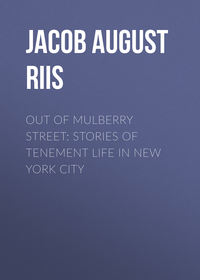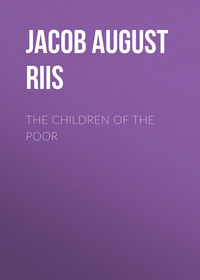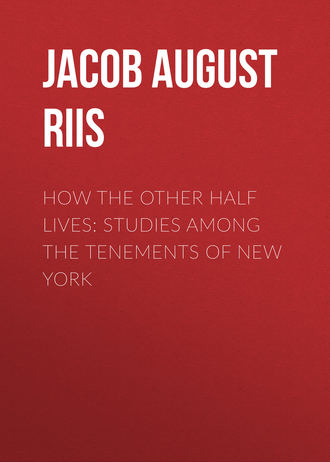 полная версия
полная версияHow the Other Half Lives: Studies Among the Tenements of New York
I have aimed to set down a few dry facts merely. They carry their own comment. Back of the shop with its weary, grinding toil—the home in the tenement, of which it was said in a report of the State Labor Bureau: “Decency and womanly reserve cannot be maintained there—what wonder so many fall away from virtue?” Of the outlook, what? Last Christmas Eve my business took me to an obscure street among the West Side tenements. An old woman had just fallen on the doorstep, stricken with paralysis. The doctor said she would never again move her right hand or foot. The whole side was dead. By her bedside, in their cheerless room, sat the patient’s aged sister, a hopeless cripple, in dumb despair. Forty years ago the sisters had come, five in number then, with their mother, from the North of Ireland to make their home and earn a living among strangers. They were lace embroiderers and found work easily at good wages. All the rest had died as the years went by. The two remained and, firmly resolved to lead an honest life, worked on though wages fell and fell as age and toil stiffened their once nimble fingers and dimmed their sight. Then one of them dropped out, her hands palsied and her courage gone. Still the other toiled on, resting neither by night nor by day, that the sister might not want. Now that she too had been stricken, as she was going to the store for the work that was to keep them through the holidays, the battle was over at last. There was before them starvation, or the poor-house. And the proud spirits of the sisters, helpless now, quailed at the outlook.
These were old, with life behind them. For them nothing was left but to sit in the shadow and wait. But of the thousands, who are travelling the road they trod to the end, with the hot blood of youth in their veins, with the love of life and of the beautiful world to which not even sixty cents a day can shut their eyes—who is to blame if their feet find the paths of shame that are “always open to them?” The very paths that have effaced the saving “limit,” and to which it is declared to be “inevitable that they must in many instances resort.” Let the moralist answer. Let the wise economist apply his rule of supply and demand, and let the answer be heard in this city of a thousand charities where justice goes begging.
To the everlasting credit of New York’s working-girl let it be said that, rough though her road be, all but hopeless her battle with life, only in the rarest instances does she go astray. As a class she is brave, virtuous, and true. New York’s army of profligate women is not, as in some foreign cities, recruited from her ranks. She is as plucky as she is proud. That “American girls never whimper” became a proverb long ago, and she accepts her lot uncomplainingly, doing the best she can and holding her cherished independence cheap at the cost of a meal, or of half her daily ration, if need be. The home in the tenement and the traditions of her childhood have neither trained her to luxury nor predisposed her in favor of domestic labor in preference to the shop. So, to the world she presents a cheerful, uncomplaining front that sometimes deceives it. Her courage will not be without its reward. Slowly, as the conviction is thrust upon society that woman’s work must enter more and more into its planning, a better day is dawning. The organization of working girls’ clubs, unions, and societies with a community of interests, despite the obstacles to such a movement, bears testimony to it, as to the devotion of the unselfish women who have made their poorer sisters’ cause their own, and will yet wring from an unfair world the justice too long denied her.
CHAPTER XXI.
PAUPERISM IN THE TENEMENTS
The reader who has followed with me the fate of the Other Half thus far, may not experience much of a shock at being told that in eight years 135,595 families in New York were registered as asking or receiving charity. Perhaps, however, the intelligence will rouse him that for five years past one person in every ten who died in this city was buried in the Potter’s Field. These facts tell a terrible story. The first means that in a population of a million and a half, very nearly, if not quite, half a million persons were driven, or chose, to beg for food, or to accept it in charity at some period of the eight years, if not during the whole of it. There is no mistake about these figures. They are drawn from the records of the Charity Organization Society, and represent the time during which it has been in existence. It is not even pretended that the record is complete. To be well within the limits, the Society’s statisticians allow only three and a half to the family, instead of the four and a half that are accepted as the standard of calculations which deal with New York’s population as a whole. They estimate upon the basis of their every-day experience that, allowing for those who have died, moved away, or become for the time being at least self-supporting, eighty-five per cent. of the registry are still within, or lingering upon, the borders of dependence. Precisely how the case stands with this great horde of the indigent is shown by a classification of 5,169 cases that were investigated by the Society in one year. This was the way it turned out: 327 worthy of continuous relief, or 6.4 per cent.; 1,269 worthy of temporary relief, or 24.4 per cent.; 2,698 in need of work, rather than relief, or 52.2 per cent.; 875 unworthy of relief, or 17 per cent.
That is, nearly six and a half per cent, of all were utterly helpless—orphans, cripples, or the very aged; nearly one-fourth needed just a lift to start them on the road of independence, or of permanent pauperism, according to the wisdom with which the lever was applied. More than half were destitute because they had no work and were unable to find any, and one-sixth were frauds, professional beggars, training their children to follow in their foot-steps—a veritable “tribe of Ishmael,” tightening its grip on society as the years pass, until society shall summon up pluck to say with Paul, “if any man will not work neither shall he eat,” and stick to it. It is worthy of note that almost precisely the same results followed a similar investigation in Boston. There were a few more helpless cases of the sort true charity accounts it a gain to care for, but the proportion of a given lot that was crippled for want of work, or unworthy, was exactly the same as in this city. The bankrupt in hope, in courage, in purse, and in purpose, are not peculiar to New York. They are found the world over, but we have our full share. If further proof were wanted, it is found in the prevalence of pauper burials. The Potter’s Field stands ever for utter, hopeless surrender. The last the poor will let go, however miserable their lot in life, is the hope of a decent burial. But for the five years ending with 1888 the average of burials in the Potter’s Field has been 10.03 per cent. of all. In 1889 it was 9.64. In that year the proportion to the total mortality of those who died in hospitals, institutions, and in the Almshouse was as 1 in 5.
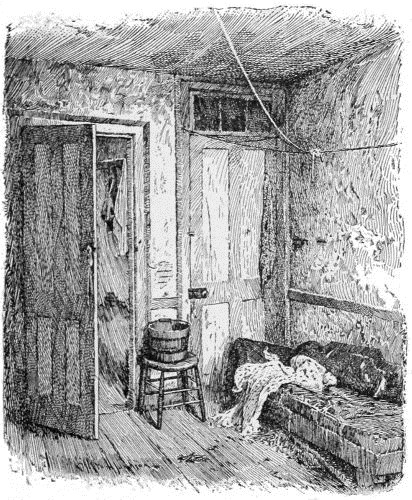
A FLAT IN THE PAUPER BARRACKS, WEST THIRTY-EIGHTH STREET, WITH ALL ITS FURNITURE.
The 135,595 families inhabited no fewer than 31,000 different tenements. I say tenements advisedly, though the society calls them buildings, because at least ninety-nine per cent. were found in the big barracks, the rest in shanties scattered here and there, and now and then a fraud or an exceptional case of distress in a dwelling-house of better class. Here, undoubtedly, allowance must be made for the constant moving about of those who live on charity, which enables one active beggar to blacklist a dozen houses in the year. Still the great mass of the tenements are shown to be harboring alms-seekers. They might almost as safely harbor the small-pox. That scourge is not more contagious than the alms-seeker’s complaint. There are houses that have been corrupted through and through by this pestilence, until their very atmosphere breathes beggary. More than a hundred and twenty pauper families have been reported from time to time as living in one such tenement.
The truth is that pauperism grows in the tenements as naturally as weeds in a garden lot. A moral distemper, like crime, it finds there its most fertile soil. All the surroundings of tenement-house life favor its growth, and where once it has taken root it is harder to dislodge than the most virulent of physical diseases. The thief is infinitely easier to deal with than the pauper, because the very fact of his being a thief presupposes some bottom to the man. Granted that it is bad, there is still something, a possible handle by which to catch him. To the pauper there is none. He is as hopeless as his own poverty. I speak of the pauper, not of the honestly poor. There is a sharp line between the two; but athwart it stands the tenement, all the time blurring and blotting it out. “It all comes down to character in the end,” was the verdict of a philanthropist whose life has been spent wrestling with this weary problem. And so it comes down to the tenement, the destroyer of individuality and character everywhere. “In nine years,” said a wise and charitable physician, sadly, to me, “I have known of but a single case of permanent improvement in a poor tenement family.” I have known of some, whose experience, extending over an even longer stretch, was little better.
The beggar follows the “tough’s” rule of life that the world owes him a living, but his scheme of collecting it stops short of violence. He has not the pluck to rob even a drunken man. His highest flights take in at most an unguarded clothes-line, or a little child sent to buy bread or beer with the pennies he clutches tightly as he skips along. Even then he prefers to attain his end by stratagem rather than by force, though occasionally, when the coast is clear, he rises to the height of the bully. The ways he finds of “collecting” under the cloak of undeserved poverty are numberless, and often reflect credit on the man’s ingenuity, if not on the man himself. I remember the shock with which my first experience with his kind—her kind, rather, in this case: the beggar was a woman—came home to me. On my way to and from the office I had been giving charity regularly, as I fondly believed, to an old woman who sat in Chatham Square with a baby done up in a bundle of rags, moaning piteously in sunshine and rain, “Please, help the poor.” It was the baby I pitied and thought I was doing my little to help, until one night I was just in time to rescue it from rolling out of her lap, and found the bundle I had been wasting my pennies upon just rags and nothing more, and the old hag dead drunk. Since then I have encountered bogus babies, borrowed babies, and drugged babies in the streets, and fought shy of them all. Most of them, I am glad to say, have been banished from the street since; but they are still occasionally to be found. It was only last winter that the officers of the Society for the Prevention of Cruelty to Children arrested an Italian woman who was begging along Madison Avenue with a poor little wreck of a girl, whose rags and pinched face were calculated to tug hard at the purse-strings of a miser. Over five dollars in nickles and pennies were taken from the woman’s pockets, and when her story of poverty and hunger was investigated at the family’s home in a Baxter Street tenement, bank-books turned up that showed the Masonis to be regular pauper capitalists, able to draw their check for three thousand dollars, had they been so disposed. The woman was fined $250, a worse punishment undoubtedly than to have sent her to prison for the rest of her natural life. Her class has, unhappily, representatives in New York that have not yet been brought to grief.
Nothing short of making street begging a crime has availed to clear our city of this pest to an appreciable extent. By how much of an effort this result has been accomplished may be gleaned from the fact that the Charity Organization Society alone, in five years, caused the taking up of 2,594 street beggars, and the arrest and conviction of 1,474 persistent offenders. Last year it dealt with 612 perambulating mendicants. The police report only 19 arrests for begging during the year 1889, but the real facts of the case are found under the heading “vagrancy.” In all, 2,633 persons were charged with this offence, 947 of them women. A goodly proportion of these latter came from the low groggeries of the Tenth Ward, where a peculiar variety of the female tramp-beggar is at home, the “scrub.” The scrub is one degree perhaps above the average pauper in this, that she is willing to work at least one day in the week, generally the Jewish Sabbath. The orthodox Jew can do no work of any sort from Friday evening till sunset on Saturday, and this interim the scrub fills out in Ludlow Street. The pittance she receives for this vicarious sacrifice of herself upon the altar of the ancient faith buys her rum for at least two days of the week at one of the neighborhood “morgues.” She lives through the other four by begging. There are distilleries in Jewtown, or just across its borders, that depend almost wholly on her custom. Recently, when one in Hester Street was raided because the neighbors had complained of the boisterous hilarity of the hags over their beer, thirty two aged “scrubs” were marched off to the station-house.
It is curious to find preconceived notions quite upset in a review of the nationalities that go to make up this squad of street beggars. The Irish head the list with fifteen per cent., and the native American is only a little way behind with twelve per cent., while the Italian, who in his own country turns beggary into a fine art, has less than two per cent. Eight per cent. were Germans. The relative prevalence of the races in our population does not account for this showing. Various causes operate, no doubt, to produce it. Chief among them is, I think, the tenement itself. It has no power to corrupt the Italian, who comes here in almost every instance to work—no beggar would ever emigrate from anywhere unless forced to do so. He is distinctly on its lowest level from the start. With the Irishman the case is different. The tenement, especially its lowest type, appears to possess a peculiar affinity for the worse nature of the Celt, to whose best and strongest instincts it does violence, and soonest and most thoroughly corrupts him. The “native” twelve per cent. represent the result of this process, the hereditary beggar of the second or third generation in the slums.
The blind beggar alone is winked at in New York’s streets, because the authorities do not know what else to do with him. There is no provision for him anywhere after he is old enough to strike out for himself. The annual pittance of thirty or forty dollars which he receives from the city serves to keep his landlord in good humor; for the rest his misfortune and his thin disguise of selling pencils on the street corners must provide. Until the city affords him some systematic way of earning his living by work (as Philadelphia has done, for instance) to banish him from the street would be tantamount to sentencing him to death by starvation. So he possesses it in peace, that is, if he is blind in good earnest, and begs without “encumbrance.” Professional mendicancy does not hesitate to make use of the greatest of human afflictions as a pretence for enlisting the sympathy upon which it thrives. Many New Yorkers will remember the French school-master who was “blinded by a shell at the siege of Paris,” but miraculously recovered his sight when arrested and deprived of his children by the officers of Mr. Gerry’s society. When last heard of he kept a “museum” in Hartford, and acted the overseer with financial success. His sign with its pitiful tale, that was a familiar sight in our streets for years and earned for him the capital upon which he started his business, might have found a place among the curiosities exhibited there, had it not been kept in a different sort of museum here as a memento of his rascality. There was another of his tribe, a woman, who begged for years with a deformed child in her arms, which she was found to have hired at an almshouse in Genoa for fifteen francs a month. It was a good investment, for she proved to be possessed of a comfortable fortune. Some time before that, the Society for the Prevention of Cruelty to Children, that found her out, had broken up the dreadful padrone system, a real slave trade in Italian children, who were bought of poor parents across the sea and made to beg their way on foot through France to the port whence they were shipped to this city, to be beaten and starved here by their cruel masters and sent out to beg, often after merciless mutilation to make them “take” better with a pitying public.
But, after all, the tenement offers a better chance of fraud on impulsive but thoughtless charity, than all the wretchedness of the street, and with fewer risks. To the tender-hearted and unwary it is, in itself, the strongest plea for help. When such a cry goes up as was heard recently from a Mott Street den, where the family of a “sick” husband, a despairing mother, and half a dozen children in rags and dirt were destitute of the “first necessities of life,” it is not to be wondered at that a stream of gold comes pouring in to relieve. It happens too often, as in that case, that a little critical inquiry or reference to the “black list” of the Charity Organization Society, justly dreaded only by the frauds, discovers the “sickness” to stand for laziness, and the destitution to be the family’s stock in trade; and the community receives a shock that for once is downright wholesome, if it imposes a check on an undiscriminating charity that is worse than none at all.
The case referred to furnished an apt illustration of how thoroughly corrupting pauperism is in such a setting. The tenement woke up early to the gold mine that was being worked under its roof, and before the day was three hours old the stream of callers who responded to the newspaper appeal found the alley blocked by a couple of “toughs,” who exacted toll of a silver quarter from each tearful sympathizer with the misery in the attic.
A volume might be written about the tricks of the professional beggar, and the uses to which he turns the tenement in his trade. The Boston “widow” whose husband turned up alive and well after she had buried him seventeen times with tears and lamentation, and made the public pay for the weekly funerals, is not without representatives in New York. The “gentleman tramp” is a familiar type from our streets, and the “once respectable Methodist” who patronized all the revivals in town with his profitable story of repentance, only to fall from grace into the saloon door nearest the church after the service was over, merely transferred the scene of his operations from the tenement to the church as the proper setting for his specialty. There is enough of real suffering in the homes of the poor to make one wish that there were some effective way of enforcing Paul’s plan of starving the drones into the paths of self-support: no work, nothing to eat.
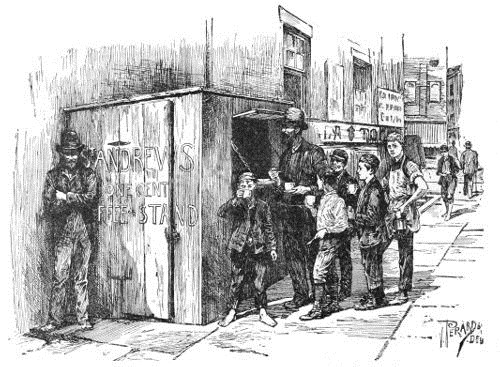
COFFEE AT ONE CENT.
The message came from one of the Health Department’s summer doctors, last July, to the King’s Daughters’ Tenement-house Committee, that a family with a sick child was absolutely famishing in an uptown tenement. The address was not given. The doctor had forgotten to write it down, and before he could be found and a visitor sent to the house the baby was dead, and the mother had gone mad. The nurse found the father, who was an honest laborer long out of work, packing the little corpse in an orange-box partly filled with straw, that he might take it to the Morgue for pauper burial. There was absolutely not a crust to eat in the house, and the other children were crying for food. The great immediate need in that case, as in more than half of all according to the record, was work and living wages. Alms do not meet the emergency at all. They frequently aggravate it, degrading and pauperizing where true help should aim at raising the sufferer to self-respect and self-dependence. The experience of the Charity Organization Society in raising, in eight years, 4,500 families out of the rut of pauperism into proud, if modest, independence, without alms, but by a system of “friendly visitation,” and the work of the Society for Improving the Condition of the Poor and kindred organizations along the same line, shows what can be done by well-directed effort. It is estimated that New York spends in public and private charity every year a round $8,000,000. A small part of this sum intelligently invested in a great labor bureau, that would bring the seeker of work and the one with work to give together under auspices offering some degree of mutual security, would certainly repay the amount of the investment in the saving of much capital now worse than wasted, and would be prolific of the best results. The ultimate and greatest need, however, the real remedy, is to remove the cause—the tenement that was built for “a class of whom nothing was expected,” and which has come fully up to the expectation. Tenement-house reform holds the key to the problem of pauperism in the city. We can never get rid of either the tenement or the pauper. The two will always exist together in New York. But by reforming the one, we can do more toward exterminating the other than can be done by all other means together that have yet been invented, or ever will be.
CHAPTER XXII.
THE WRECKS AND THE WASTE
Pauperdom is to blame for the unjust yoking of poverty with punishment, “charities” with “correction,” in our municipal ministering to the needs of the Nether Half. The shadow of the workhouse points like a scornful finger toward its neighbor, the almshouse, when the sun sets behind the teeming city across the East River, as if, could its stones speak, it would say before night drops its black curtain between them: “You and I are brothers. I am not more bankrupt in moral purpose than you. A common parent begat us. Twin breasts, the tenement and the saloon, nourished us. Vice and unthrift go hand in hand. Pauper, behold thy brother!” And the almshouse owns the bitter relationship in silence.
Over on the islands that lie strung along the river and far up the Sound the Nether Half hides its deformity, except on show-days, when distinguished visitors have to be entertained and the sore is uncovered by the authorities with due municipal pride in the exhibit. I shall spare the reader the sight. The aim of these pages has been to lay bare its source. But a brief glance at our proscribed population is needed to give background and tone to the picture. The review begins with the Charity Hospital with its thousand helpless human wrecks; takes in the penitentiary, where the “tough” from Battle Row and Poverty Gap is made to earn behind stone walls the living the world owes him; a thoughtless, jolly convict-band with opportunity at last “to think” behind the iron bars, but little desire to improve it; governed like unruly boys, which in fact most of them are. Three of them were taken from the dinner-table while I was there one day, for sticking pins into each other, and were set with their faces to the wall in sight of six hundred of their comrades for punishment. Pleading incessantly for tobacco, when the keeper’s back is turned, as the next best thing to the whiskey they cannot get, though they can plainly make out the saloon-signs across the stream where they robbed or “slugged” their way to prison. Every once in a while the longing gets the best of some prisoner from the penitentiary or the workhouse, and he risks his life in the swift currents to reach the goal that tantilizes him with the promise of “just one more drunk.” The chances are at least even of his being run down by some passing steamer and drowned, even if he is not overtaken by the armed guards who patrol the shore in boats, or his strength does not give out.
This workhouse comes next, with the broken-down hordes from the dives, the lodging-houses, and the tramps’ nests, the “hell-box”22 rather than the repair-shop of the city. In 1889 the registry at the workhouse footed up 22,477, of whom some had been there as many as twenty times before. It is the popular summer resort of the slums, but business is brisk at this stand the year round. Not a few of its patrons drift back periodically without the formality of a commitment, to take their chances on the island when there is no escape from the alternative of work in the city. Work, but not too much work, is the motto of the establishment. The “workhouse step” is an institution that must be observed on the island, in order to draw any comparison between it and the snail’s pace that shall do justice to the snail. Nature and man’s art have made these islands beautiful; but weeds grow luxuriantly in their gardens, and spiders spin their cobwebs unmolested in the borders of sweet-smelling box. The work which two score of hired men could do well is too much for these thousands.










